10/25/2020 – The attraction to muzzleloaders
Why would anyone want to own and/or shoot a muzzleloader? They are fun. It is almost impossible to not like a firearm that can generate five feet of smoke and muzzle blast, while launching a .50 caliber projectile accurately and at a more than respectable clip.
Muzzleloading firearms can be quite cost effective. Quality, accurate and reliable production muzzleloaders can be had at value prices, starting under $170 and top out at approximately $2,000. Custom muzzleloaders can easily reach $20,000 for period correct designs, driven by select materials and highly refined wood and metal work.
On a federal level, and at some state and local government levels, muzzleloaders are not classified as firearms and fall outside of ATF jurisdiction. Subsequently, in some overly restricted locations, a muzzleloader can be owned where other firearms cannot. As with all things legal, there are exceptions and stipulations.
Put a bunch of people in a room and call them lawmakers
While states differ greatly on the permitted use of centerfire rifles for hunting, muzzleloaders are legal for hunting in all fifty states. In most, muzzleloader seasons are at the best times and with the least competition for good hunting areas, except from those pretentious bow hunters as, in most cases, muzzleloader season coincides with bow season. Bow hunters are like Volvo drivers who occupy the fast lane of an interstate highway with their vehicle’s cruise control set exactly at the speed limit. Not that I’m judging.
Muzzleloader hunting challenges stalking and marksmanship skills where states dictate restrictions such as metallic sights only and conical or round ball projectiles. Muzzleloader hunting challenge long range shooting skills where optical sights and high ballistic coefficient sabot loads are permitted.
Regulations controlling the use of muzzle loaders during hunting seasons vary. Maine muzzleloader hunting laws allow the use of the most evolved muzzleloaders, and pellet formed powder and sabot mounted bullets, with the caveat that .40 caliber is the minimum bore size.
Colorado, deeply invested in firearm ownership regulations and hunting laws, does the same for muzzleloader hunters… .50 caliber for elk and moose and .40 caliber for smaller game with defined associated bullet weights. Pellet form black powder and black powder substitutes are not legal for hunting, nor are sabot mounted projectiles or use of optical sights.
My road to muzzleloaders has followed a winding and curious path
My first exposure of consequence to muzzleloaders was a little over twenty years ago. The circumstances and incidences were well documented in the three part series that begins with “Click…., and then bang Part I“. A .45 Caliber CVA HunterBolt 209 Magnum rifle, an unencumbered $290 purchase in blister pack.. the rifle, not me, that provided an invaluable muzzle education; projectiles, powder, accessories, tools, potential, and how to shoot and clean a muzzleloader. A tremendously enjoyable experience. A rifle I still own.
For as much fun as I have had with muzzleloaders, it has been a couple of years since I’ve written about them. Perhaps because my last muzzleloader project was with a Remington Ultimate Muzzleloader. Bolt action receiver, 308 Winchester case based U.M.L ignition device, Pyrodex pellets… lots of them, and .50 caliber sabot mounted 0.452″ bullets, I felt as though I were shooting a reloading press.Too specialized to enjoy and regulated out of hunting use in several states. I missed shooting a muzzle loader, so…
The Thompson/Center Encore Pro Hunter XT 50 Cal
 The Thompson/Center Pro Hunter XT 50 Caliber meets requirements in all states with an inline design that permits the use of either granular or pellet form black powder and synthetics, common 209 primers for ignition and an ability to shoot sabot mounted, conical or round projectiles. The subject Thompson / Center Encore Pro Hunter XT, with interchangeable barrel capability, falls comfortably into the mid price range with a starting MSRP of $749 and a subject rifle MSRP of $1,004.
The Thompson/Center Pro Hunter XT 50 Caliber meets requirements in all states with an inline design that permits the use of either granular or pellet form black powder and synthetics, common 209 primers for ignition and an ability to shoot sabot mounted, conical or round projectiles. The subject Thompson / Center Encore Pro Hunter XT, with interchangeable barrel capability, falls comfortably into the mid price range with a starting MSRP of $749 and a subject rifle MSRP of $1,004.
Owners can expand the capability of their Encore Pro Hunter XT by purchasing any one of thirteen 20″ barrels, or fourteen 28″ barrels, chambered for a wide variety of centerfire cartridges. Barrel MSRP ranges from $368.99 to $432.99, dependent upon barrel length and chamber. Where the interchangeable barrel system is not needed, or in states where mandated, a fixed barrel Pro Hunter FX, is available, with an MSRP starting at $649.
| Thompson / Center Encore Pro Hunter XT | |
| Model | 28205722 |
| Point of Origin | U.S.A. |
| Type | Inline/Break Action |
| Caliber | .50 |
| Barrel Length | 28 |
| Barrel Material | Stainless Steel |
| Capacity | 1 |
| Rate of Twist | 1:28″ |
| Ignition | 209 Primer |
| Stock | Black FlexTech |
| Length of Pull | 14″ |
| Overall Length | 42.5″ |
| Weight | 8.25 Lbs |
| Sights | Adjustable Fiber Optic |
| MSRP | $1,004 |
At the center of the Encore Pro Hunter XT universe is the Encore single shot action. Introduced in 1983 to offer greater cartridge capacity than the Contender, the Encore features a more robust design; larger frame, larger hinge pin, larger diameter barrel breech, and a then newly designed trigger that parks the hammer off the firing pin and can be cocked without opening and closing the action as was necessary with the original G1 Contender.
A number of improvements were carried over to the 1995 G2 replacement for the original Contender. However, the G2 remains a low to moderate pressure action. Unlike the G2 45-70 Gov’t that is limited to standard pressure ammunition, 28,000 psi, the Encore handles modern 45-70 ammunition. The break action Encore can accommodate rifle, pistol, shotgun, and muzzleloader barrels through to the 500 S&W Magnum (60,000 psi) and the belted 300 Win Mag (64,000 psi).
More specifically…
The hammer position default is center, however, it can be positioned left or right to clear scope eye pieces. The extractor cleanly pulls spent primers pops the little suckers out when the action is opened after discharge. No, not military discharge, muzzleloader discharge. Breech plug removal is accomplished rotating the the extractor to the side and down and turning the breech plug counter clockwise and wiggling it straight back and out.
The subject rifle utilized the Speed Breech XT breech plug system, an interrupted screw design. I know, rude, right? No, unlike a moderator at a Presidential debate, interruption in this case is a good thing. Threads on the plug extend only 180 degrees around the circumference of the plug, leaving two unthreaded flats 180° apart. Subsequently, it take only a 90° turn of the breech plug to free it for removal. The design has been in service for this type of application since 1845 when it was first applied to the locking breech block on cannons. It makes for an easy to clean system.
Removing and installing barrels is quite simple. After verifying an unloaded condition, the forearm is removed by loosening two fasteners, the trigger guard spur is pulled rearward to unlock the action, the barrel is tipped downward, the hinge pin is pushed out, and the barrel is separated from the receiver. Mechanical access like this is not typical for muzzleloaders and muzzleloaders require frequent cleaning to function at their best.
So two minutes also to change the Thompson / Center Encore Pro Hunter XT from a 50 caliber muzzle loader, to a 12 gauge shotgun, to a 22-250 Rem, to a .458 Lott* . Yes, I know that Thompson / Center does not list the 458 Lott as a production barrel. T/C stops at the 300 Win Mag, but the aftermarket supply of quality barrels for the Encore is massive. One of the reasons I have been shooting a T/C system firearm since the mid 70’s is in support of my love of handloading and the fact there are so many interesting cartridges out there to work with. The Encore is a good way to get there.
Muzzleloader recoil with black powder and synthetic substitutes is sharp, if not heavy. I alway feel like my shoulder is being smacked rather than pushed. Subsequently, I tend to be more interested in features associated with recoil management. Thompson / Center utilizes the FlexTech system developed for them by Sims Vibration Laboratory.
At the far end is a Sims Vibration Laboratory LimbSaver recoil pad, which in itself is an effective recoil reducer. Embedded in the stock are four recoil arches that give under recoil, preabsorbing recoil shock before it gets to the recoil pad. The result is a 43% reduction in transferred recoil. Yes, it might be 42% or 44%, but I think you may be missing the bigger picture; relatively soft shooting with 150 grain powder charges.
Since there is a picture of the muzzle… before I get onto other things and forget, the muzzle has a short section, about sabot round in length, that is groove diameter and devoid of rifling. Thompson / Center refers to this feature as Quick Load Accurizor. Its intent is to make reloading easier for the hunter, which it does by reducing effort in getting a sabot started down.
As is my practice, I run a patch down the bore after each shot, but I could have reduced that to every other even with tight fitting sabots. PowerBelt bullets could have been stretched to three. Why do I run a patch every round? Because I hate unloading a muzzle loader with a projectile lodged in powder residue an inch above the powder charge.
The Thompson/Center Encore Pro Hunter XT has excellent fiber optic, fully adjustable sights. They are bright against virtually any backdrop and fine enough in adjustment and elements for critical aiming. The Encore is also drilled and taped for bases or a rail, which means its owner can mount a scope, red dot, lasers, or anything else industry marketing geniuses can dream up.
Yes, I did shoot the Pro Hunter. Thanks for ruining the surprise
| Bullet | Type | Weight Grains |
100 Grain FPS |
100 Yard 3 Shot Groups |
150 Grain FPS |
100 Yard 3 Shot Group |
| PowerBelt | Copper HPFB | 250 | 1749 | 1.2 |
2099 | 1.6 |
| Barnes Spit-Fire MZ | Copper HPBT | 245 | 1762 | 1.2 |
2114 | 1.3 |
| Barnes Spit-Fire TMZ | Copper PTBT | 250 | 1770 | 1.6 |
2127 | 1.3 |
| Remington AccuTip | Copper PTFB | 250 | 1735 | 0.8 |
2090 | 1.0 |
| Hornady SST | Jacketed PTFB | 300 | 1728 | 1.3 |
2031 | 1.2 |
Scope mounted results were very good. Using combinations of Pyrodex 50/50 pellets, there was no fine tuning or charges or powder type. My favorite was actually a 50 yard target shot with the fiber optics sights, which was probably closer to a Maine deer hunting setting.

I do not zero a rifle for every combination when shooting groups, because point of impact shifts and I am too frugal and a tad too lazy to zero for each. I just want group size. This /4″ was shot with 150 grains of Pyrodex behind a 250 grain PowerBelt at +/- 2090 fps, running a brush and patch through the breech end between shots.
How well do these sabots fly?
| Barnes TMZ 250 grain Best Zero Results | |||||||
| Near-Zero – yds. | 13 | Mid Range – yds. | 91 | ||||
| Far-Zero – yds. | 162 | Max Ordinate – in. | +3.0 | ||||
| Point Blank – yds. | 204 | ||||||
| Yards | 0 | 50 | 100 | 150 | 200 | 250 | 300 | |||||
| Velocity – fps | 2127 | 1944 | 1771 | 1609 | 1462 | 1330 | 1218 | |||||
| Energy – ft.-lbs. | 2511 | 2098 | 1741 | 1437 | 1186 | 982 | 824 | |||||
| Momentum – lbs-sec | 76 | 69 | 63 | 57 | 52 | 47 | 44 | |||||
| Path – in. | -1.00 | 2.13 | 2.95 | 0.99 | -4.34 | -13.74 | -28.06 | |||||
| Drift – in. | 0.00 | 0.00 | 0.00 | 0.00 | 0.00 | 0.00 | 0.00 | |||||
| Time Of Flight – sec. | 0.00 | 0.07 | 0.15 | 0.24 | 0.34 | 0.45 | 0.57 | |||||
No, I am not promoting the Thompson / Center Encore Pro Hunter XT as a casual 300 yard muzzle loader. 300 Yards is a long ways off for most shooter, regardless the type of firearm selected, but this is solid 200 yard performance which is a lot of reach for any big bore. The 250 grain bullet is clearly pulling along enough velocity, kinetic energy and momentum to assure good penetration and bullet expansion.
Conclusion…s
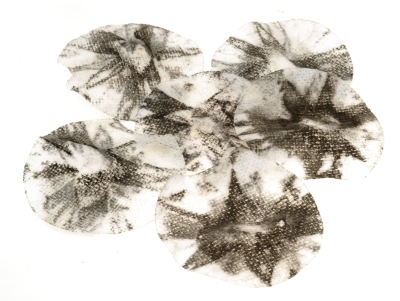 The Thompson / Center Encore Pro Hunter XT is a quality firearm; fit, finish, materials, and features. As has been the case with T/C firearms since 1965. Dare to be different, the company has followed their own design path with well considered, useful innovation.
The Thompson / Center Encore Pro Hunter XT is a quality firearm; fit, finish, materials, and features. As has been the case with T/C firearms since 1965. Dare to be different, the company has followed their own design path with well considered, useful innovation.
As a muzzleloader, the single shot Encore platform is a natural, particularly with the forward potential of so many interchangeable cartridge barrels. As a cartridge firearm, the same applies, with so much potential as a shotgun or muzzle loader for future applications.
As a muzzleloader, as is typical of the firearm type, cleaning patches and a cleaning rod got quite a work out. Somehow the effort became minuscule in the face of so much fun.

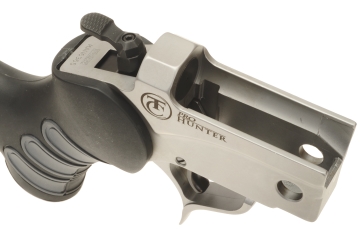
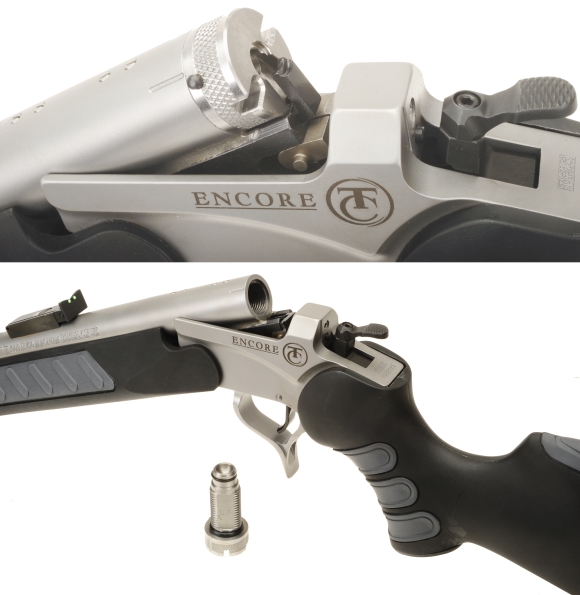
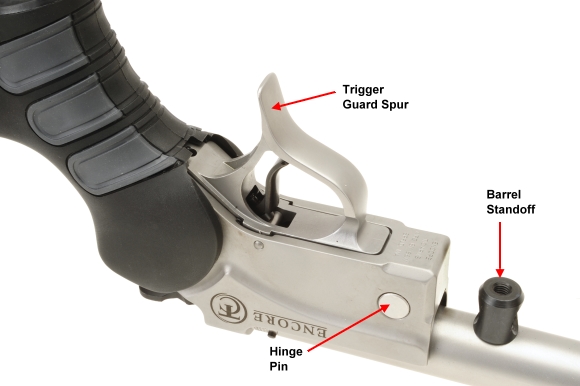
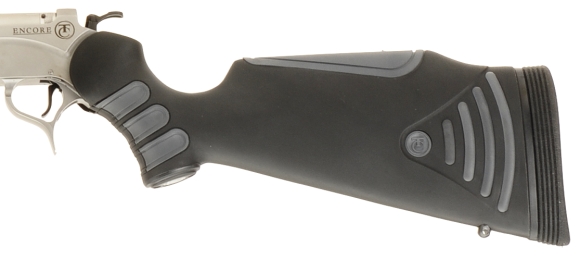
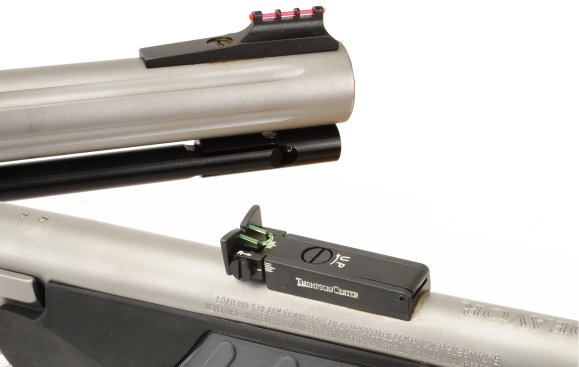


Email Notification